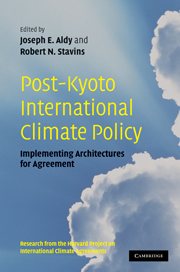Book contents
- Frontmatter
- Contents
- Harvard Environmental Economics Program, International Advisory Board
- Harvard Project on International Climate Agreements, Faculty Steering Committee
- Harvard Project on International Climate Agreements, Project Management
- List of figures
- List of tables
- List of contributors
- Foreword
- 1 Introduction
- Part I Alternative international policy architectures
- Part II Negotiation, assessment, and compliance
- 9 How to negotiate and update climate agreements
- 10 Metrics for evaluating policy commitments in a fragmented world: the challenges of equity and integrity
- 11 Justice and climate change: the unpersuasive case for per capita allocations of emissions rights
- 12 Toward a post-Kyoto climate change architecture: a political analysis
- Part III The role and means of technology transfer
- Part IV Global climate policy and international trade
- Part V Economic development, adaptation, and deforestation
- Part VI Modeling impacts of alternative allocations of responsibility
- Part VII Synthesis and conclusion
- Appendix A Selected List of Individuals Consulted, Harvard Project on International Climate Agreements
- Appendix B Workshops and Conferences, Harvard Project on International Climate Agreements
- Glossary and Abbreviations
- Index
11 - Justice and climate change: the unpersuasive case for per capita allocations of emissions rights
Published online by Cambridge University Press: 05 June 2012
- Frontmatter
- Contents
- Harvard Environmental Economics Program, International Advisory Board
- Harvard Project on International Climate Agreements, Faculty Steering Committee
- Harvard Project on International Climate Agreements, Project Management
- List of figures
- List of tables
- List of contributors
- Foreword
- 1 Introduction
- Part I Alternative international policy architectures
- Part II Negotiation, assessment, and compliance
- 9 How to negotiate and update climate agreements
- 10 Metrics for evaluating policy commitments in a fragmented world: the challenges of equity and integrity
- 11 Justice and climate change: the unpersuasive case for per capita allocations of emissions rights
- 12 Toward a post-Kyoto climate change architecture: a political analysis
- Part III The role and means of technology transfer
- Part IV Global climate policy and international trade
- Part V Economic development, adaptation, and deforestation
- Part VI Modeling impacts of alternative allocations of responsibility
- Part VII Synthesis and conclusion
- Appendix A Selected List of Individuals Consulted, Harvard Project on International Climate Agreements
- Appendix B Workshops and Conferences, Harvard Project on International Climate Agreements
- Glossary and Abbreviations
- Index
Summary
Introduction
Many people believe that the problem of climate change should be handled by an international cap-and-trade system. Under this approach, participating nations, and perhaps the entire world, would create a “cap” on greenhouse gas (GHG) emissions. Nations would be allocated specified emissions rights, which could be traded in return for cash. Other people have doubts about whether such a system is practical, and it is becoming increasingly likely that some other approach will be used—for example, a cap-and-trade system in the north along with technical and financial assistance and general targets for the south.
Both types of system raise broad questions of welfare and justice. Consider, for example, the cap-and-trade system. The proposal for such a system does not answer a crucial question: how should emissions rights be allocated? It is tempting to suggest that the status quo, across nations, provides the appropriate baseline. According to one view, emissions might be frozen at existing levels, so that every nation has the right to its current level of emissions. Taking a more aggressive view, all or most signatory nations should have to reduce their emissions levels by a specified percentage, again taking the status quo as the foundation for reductions. The status quo might seem to have intuitive appeal, but it is also somewhat arbitrary and raises serious questions from the standpoint of equity. Why should climate change policy take existing national emissions, and to that extent existing national patterns of energy use, as a given for policy purposes?
- Type
- Chapter
- Information
- Post-Kyoto International Climate PolicyImplementing Architectures for Agreement, pp. 343 - 371Publisher: Cambridge University PressPrint publication year: 2009
- 1
- Cited by



